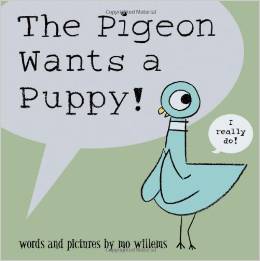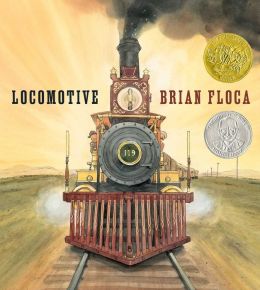Module 2 Caldecott Medal Winners/Picture Books
June 9-15, 2014
The Pigeon Wants a Puppy! by Mo Willems
Bibliography:
Willems, M. (2008). The pigeon wants a puppy! New York, NY: Hyperion Books for Children.
Willems, M. (2008). The pigeon wants a puppy! New York, NY: Hyperion Books for Children.
Summary:
Pigeon the main character of this book is rather insistent on getting his wish for a puppy. He throws a temper tantrum only to find when his wish is granted that he really is afraid of the puppy. The puppy is not at all what he was imagining with the size and the slobber. He quickly shifts his attention to another wish.
Pigeon the main character of this book is rather insistent on getting his wish for a puppy. He throws a temper tantrum only to find when his wish is granted that he really is afraid of the puppy. The puppy is not at all what he was imagining with the size and the slobber. He quickly shifts his attention to another wish.
Impressions: I loved this book. The emotions of the pigeon are relatable. I love the end how he realized he didn't really know what he was asking for at all.
Reviews:
"Up until now, the plight of the pigeon has been the strain and disappointment of a dream deferred: he didn't get to drive the bus, he didn't get to eat his whole hot dog, he didn't get to stay up late. Alas, thought, our pigeon is a romantic who won't stop wishing, and now he's wishing for a puppy. Broad hints that indicate he has no idea what to do with a puppy (I"I promise I'll water it once a mont") will start the giggles, but this time the real humor is reserved for the pigeon's getting what he wants instead of not getting it and realizing too late that it wasn't what he thought it would be like at all. To the range of emotions this one=eyed pigeon has been so articulate in conveying- he's been coy, he's been mad, he's been disappointed- Willems adds here wistful romantic fascination, complete with a kicked-up foot, clasped wings, and droopy eyelids, and affect fear, which nearly chases our bird off the page. The puppy seems benign enough with his friendly smile and waggy pink tongue, but his size relative to the pigeon gets the message across, and the pigeon's transfer of dreamy affection to a wish for a walrus puts us back on more familiar ground- if you're gonna dream, dream big enough that you are not bothered by te possibility that thee dream might come true. This is another hit for our favorite blue daydream believer. KC
Coats, K. (2008). The pigeon wants a puppy! Bulletin of the Center for Children's Books, 61(9), 405. Retrieved from http://search.proquest.com/docview/223703595?accountid=7113
Suggestions for Use:
This book could be used with young preschoolers when studying the letter P. They can talk about Pigeon and Puppy beginning with that letter, also it is a good example for teachers and librarians to point out Pigeon's behavior and is it appropriate.
This book could be used with young preschoolers when studying the letter P. They can talk about Pigeon and Puppy beginning with that letter, also it is a good example for teachers and librarians to point out Pigeon's behavior and is it appropriate.
Module 2 Caldecott Medal Winners/Picture Books
June 9-15, 2014
Locomotive by Brian Floca
Bibliography:
Floca, B. (2013). Locomotive. New York, NY: Atheneum Books for Young Readers.
Floca, B. (2013). Locomotive. New York, NY: Atheneum Books for Young Readers.
Summary: This is a beautifully illustrated book. It gives the history of the railroad across America. The illustrations are used to educate the reader on the parts of the train, the cities the trains go through as well as the landscape across the nation. It is well written and illustrated. The front and back cover gives more detailed information, maps and illustrations about the history of this time period and the design of how steam powers the engine.
Impressions: I found this to be an interesting book and enjoyed it. It was a lengthy book but the content was rich as well as the illustrations that explained the text so well it was not too much.
Reviews:
So, how much do you want to know about America's first transcontinental railroad? Just the general picture? Then follow Floca's poetic account of the fictional journey of a mother and two children riding coach class from Omaha to San Francisco just weeks after the line's completion. There's plenty to see out the window on the four-day trip, from the ever-changing landscape, to the newfangled telegraph poles, to the pitch-black tunnels and vertiginous drop from the trestle over Dale Creek. Step outside at the frequent stops to take on water, fuel, or a new engine and observe the hubbub that keeps the steam train rolling, and the makeshift towns that spring up to service travelers. If you need to know more about the "how" of steam travel, consult the annotated front endpapers that display the full route and the way the Union and Central Pacific lines came to connect; linger to browse the UP advertisements. Not enough? Take lots of time to study the cutaway and exploded details of the steam engine itself on the back endpapers (next to the CP time and fare schedule), and if you're truly among the nerdiest of train nerds, go back and compare the engines underway in the main text with the innards in the diagram. Still not sated? Floca holds forth in a dense concluding note on everything from the social history of rail travel to innovations that made running the trains safer for the crews. And if you don't care to read a word of text, be sure watch your fellow passengers packed cheek-by-jowl on the stiff bench seats, checking out the "convenience," pondering the suspect chicken dinner in a stopover diner, or, if they're luckier than you, headed for the Pullman sleeper and a good night's rest.
Bush, E.(2013). Locomotive by Brian Floca (review). Bulletin of the Center for Children's Books67(2), 89. The Johns Hopkins University Press. Retrieved June 20, 2014, from Project MUSE database.
Suggestions for Use:
This book would be great for students studying American history to use for research. Not only for American History but when studying types of fuel. This book would help students who are visual learners to understand the process better. Students could then write a report or draw their own illustration.
This book would be great for students studying American history to use for research. Not only for American History but when studying types of fuel. This book would help students who are visual learners to understand the process better. Students could then write a report or draw their own illustration.



